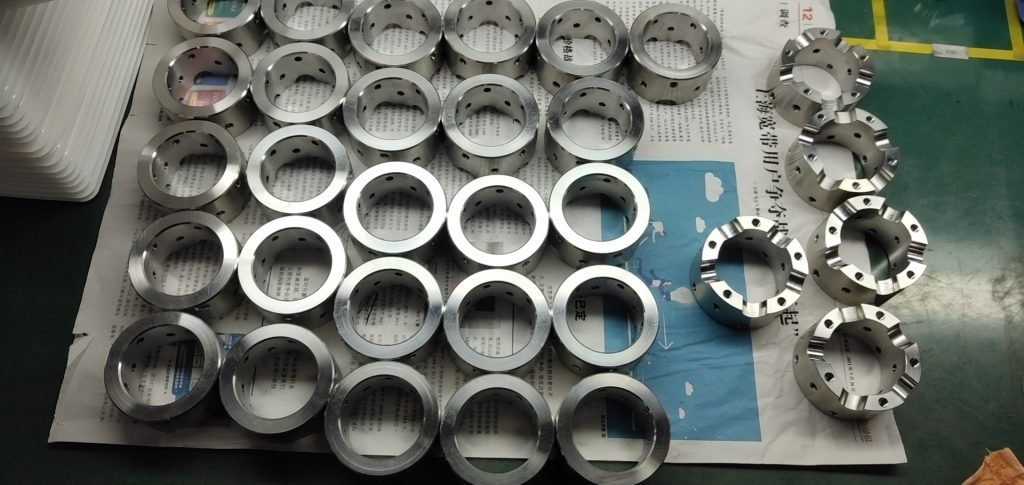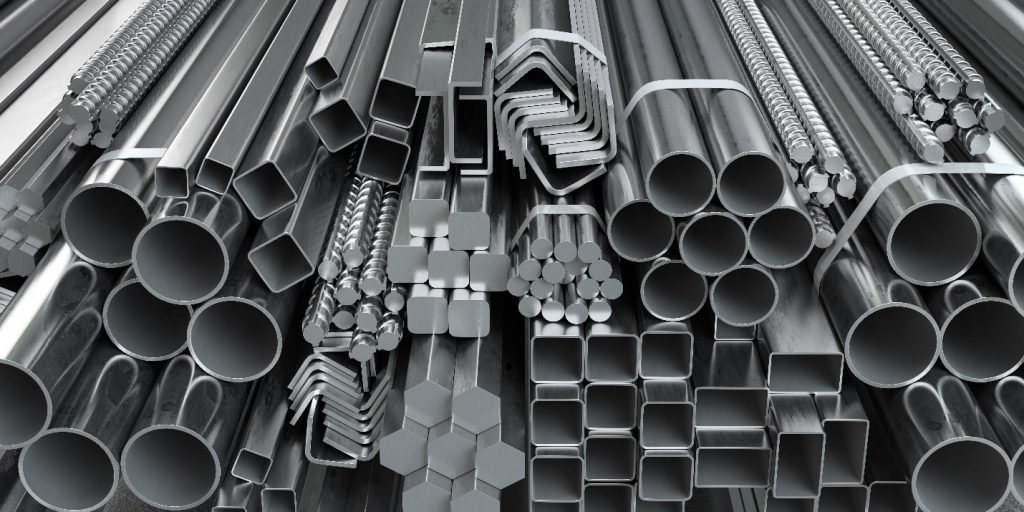Stainless steel is a group of ferrous alloys made up of a minimum of around 11% chromium. Other than this, it contains nitrogen, carbon, aluminum, sulfur, silicon, copper, titanium, nickel, selenium, molybdenum, and niobium in different proportions that give rise to different stainless steel families and grades.
Commonly a three-digit number is used to differentiate different families and grades of stainless steel like 410 stainless steel grade. The 11% of chromium helps to prevent the iron from rusting and also provides heat-resistant properties. It builds a passive film that gives stainless steel resistance against ferric oxide creation and saves the underlying substance from corrosion stroke.
Resistance to staining and corrosion, attractive appearance, high tensile strength, environmentally friendly, and low maintenance are the key attributes for an ideal material for metal fabrication. Therefore, stainless steel finds vast applications in custom machining.
Moreover, the superb ductility of stainless steel (due to having higher amounts of nickel) makes it easily transform into plates, sheets, tubing, bars, and wire. Thus, it is extensively used in surgical instruments, construction material in huge buildings, storage tanks and tankers for food and chemical products, industrial equipment (e.g., in chemical plants, paper mills, water treatment, etc.), cookware, and cutlery, and many other numerous applications.
Properties of Stainless Steel
Stainless steels offer many appealing properties like High Oxidation Resistance, Aesthetic Appeal, Recyclability, Excellent Strength at High Temperatures and Tensile Strength, Hardness, and Ductility. Due to these outstanding properties, different stainless steel families and grades are used in CNC machined products.
Anti-corrosive Property
Stainless steel offers higher oxidation resistance (or corrosion resistance) due to the inclusion of a certain percentage of chromium. Every grade must at least embrace 10.5% chromium and this percentage can go up to 26% in some grades. This excellent ability to be stainless is because chromium forms a passive layer (about 5 nanometers) on the surface that averts the iron from oxidation reaction.
Increasing the quantity of chromium makes the passive layer more stable and ultimately, the better is the corrosion resistance. This eminent aspect of stainless steel makes it applicable for fabrication in manufacturing.
Tensile Strength
Higher tensile strength is another great property of stainless steel. Precipitation hardening grades consist of both chromium and nickel. They introduce very high tensile strengths when going through heat treatment. Steels containing chromium and nickel offer a supreme synthesis of the great characteristics of martensitic and austenitic grades.
These precipitation hardening grades are generally delivered in a solution-treated condition. Different families of stainless steel have distinct yield and tensile strengths. Accordingly, these steel families and grades are used in making different products as per the requirements that can bear high stress and carry more weight.
Ductility
Having high ductile properties enable stainless steel to tolerate the strain that it faces during the CNC machining process without getting deformed. But if proper technique and equipment are not used then it might cause problems.
During cutting or sizing stainless steel, not using proper and scientific machines can create complications. Because stainless steel is hard and dissipates heat fast. It will result in a wasted piece or batch and increased project deadline and cost, of course.
Stainless Steel Grades and Families
As stainless steel has a huge number of applications and its demand is sky-high in the manufacturing field. For a particular application and need, there is a good deal of assorted stainless steel families and grades. Every grade has a fixed quantity of constituent elements which brings them many definite properties.
Choosing the right family and grade as a material for your machining project is essential. Your machinist should have a clear idea about various stainless steel categories and their associated properties. We have 5 leading families of steel. Ferritic, Austenitic, Martensitic, Duplex, and Precipitation Hardening Alloys. These families are classified based on the proportion of their constituent elements added (like chromium, nickel, silicon, nitrogen, manganese, and carbon).
Ferritic Stainless Steels
Ferritic stainless steel has very good strength. It is preferred in many fields where strength is mandatory. Its integral ingredient elements are iron and chromium and include modest amounts of other alloys. To create a powerful Ferritic alloy, these raw materials are mixed, heated, and melted together with great care. Ferritic steels have a body-centered cubic crystalline structure.
Their crystalline structure is the reason that protects the ferritic stainless steel family to become hardened when applied with heat treatment. This steel family offers comparatively cheaper grades. They are not much appealing when it comes to aesthetics and beauty.
The ferritic steel family consists of the following stainless steel grades. Every grade contains a certain composition of different elements like Nickel, Manganese, Silicon, Phosphorus, Titanium, etc.
Grade 409
Grade 409 steel provides excellent corrosion resistance and outstanding mechanical properties. It is worthy using for the productions of parts used under very high temperatures. Mostly used for automobiles exhaust systems and in those manufacturing processes that demand extreme temperatures.
Grade 416
This alloy is a free-machining ferritic stainless steel grade. Used in making screw-machined components, nuts, shafts, gears, etc. Being free-machining steel empowers it to enhance the machinability of the material by breaking the chips into tiny pieces when machined. That’s why it reduces the chances of machinery entanglement. It offers the highest machinability amongst free-machining carbon steels.
Grade 430
Grade 430 is a non-hardenable stainless steel alloy. It possesses average corrosion resistance, formability, and some associated practical mechanical properties. It is widely utilized in fabricating products for different domestic use.
Austenitic Stainless Steels
Austenitic stainless steels are 300 series alloys. This steel family contains a larger number of grades. These are amongst the most widely used grades for CNC machining fabrications. They have a face-centered cubic crystalline structure.
This stainless steel family is austenite in nature that averts them from being hardenable when they encounter heat treatment. They comprise a high proportion of chromium and nickel elements that makes them extraordinarily anti-corrosive and inherently non-magnetic.
Austenitic stainless steel offers exceptional corrosion resistance, non-magnetic behavior when annealed, ductile, and readily formable, not hardenable by applying heat treatment, good performance at high temperatures, and superb weldability. Due to these machining-friendly properties, this family of steels is used in vast CNC machining applications.
Grade 304
Grade 304 is considered the most common alloy in the austenitic stainless steel family. It consists of a high percentage of chromium and nickel elements. Preferably used in making products that you probably have seen in your pans and cookery tools. It exhibits outstanding corrosion resistance in a wide range of atmospheric environments and when interacting with other corrosives.
Grade 310
Grade 310 is a medium carbon stainless steel alloy. It offers excellent resistance to high temperatures. Therefore, mostly used in extremely heated environments such as combustion chambers and heat treatment apparatuses for its ability to withstand intense heat and scaling.
Grade 316

Grade 316 is a standard molybdenum-bearing austenitic stainless steel alloy. The inclusion of molybdenum strengthens its overall corrosion-resistant properties. Especially, crevice corrosion when it comes across chloride environments and higher resistance to pitting.
It comes in two different forms i.e. 316 and 316L. These both have their individual properties. Common uses of 316 stainless steel grade include making chemical processing equipment, valve and pump parts, jet engine parts, pharmaceutical and photographic appliances.
Martensitic Stainless Steels
Martensitic stainless steel family grades have a body-centered tetragonal crystalline structure. It offers excellent magnetic attributes, great corrosion resistance and performs well under tense environments. It contains high carbon content and chromium also.
Martensitic steel grades can be hardened and tempered through aging and different heat treatment methods because of their high carbon content. To get a certain martensitic steel grade, chromium and carbon are mixed in definite percentages that result in different grades.
This steel family offers several important grades used in numerous applications in different sectors. But the important ones that are most commonly used in CNC machining are discussed below.
Grade 431
Grade 431 is the most common and versatile alloy among the martensitic stainless steel family. It incorporates good strength and toughness with excellent corrosion resistance, torque strength, and tensile properties. 431 stainless steel can be directly machined after supplying. Due to its amazing properties, it is used in manufacturing marine systems, nuts, bolts, shafts, etc.
Grade 440
Grade 440 stainless steel alloy has high carbon content. It comes in three forms as 440a, 440b, and 440c. It offers high strength, medium corrosion resistance, and adequate hardness and wear resistance. It is used in making bearings, chisels, quality knife blades, surgical apparatus, etc.
Duplex Stainless Steels
Duplex stainless steels are formed by heating an equal proportion of ferrite and austenite elements. The reason these alloys are called duplex stainless steel grades is that their making involves both austenite and ferrite in an almost balanced percentage. Which results in excellent strength (twice the strength compared to austenitic steels), good corrosion resistance (against pitting, crevice corrosion, and stress corrosion cracking). Furthermore, duplex stainless steels possess ameliorated toughness and ductility in contrast with ferritic steel alloys.
Due to the improved qualities of duplex stainless steels, they find extensive applications in marine environments, oil and gas transportation pipes, and refining, etc. 2304 and 2205 are the most important grades used in manufacturing.
Grade 2205
Grade 2205 is an excellent stainless steel alloy. Which provides improved properties as compared to ferritic and austenitic grades. It consists of 22% of chromium, 3% of molybdenum, and 5-6% of nickel. These carefully added percentages of the constituent elements are responsible for their outstanding ameliorated attributes.
Grade 2205 is the most extensively consumed commercial duplex stainless steel. This is due to its superb qualities like corrosion resistance, high strength, good weldability, and workability.
Grade 2304
These duplex stainless steel grades do not contain any molybdenum. They offer improved properties in contrast to grade 316 alloys. They have good corrosion resistance and high strength attributes. They are used in the construction sector, pulp and paper industry, and sanitation pipes.
Precipitation Hardening Stainless Steels
This family of stainless steel is available in the market in two conditions. Either in condition A (annealed) or condition C (tempered). They are magnetic, stronger, heat treatable, and offer great workability. They can provide tensile strengths of 850-1700 MPa and yield strengths of 520-1500 MPa when heat treated.
15-5 PH (15% chromium, 5 % nickel)
This precipitation hardening stainless steel grade contains 15% chromium, 5% nickel, and a minor percentage of other elements. It offers outstanding corrosion resistance, high strength, and hardness. It is broadly used in creating petroleum, and nuclear reactor components, shafts, valves, gear, etc.
17-4PH (17% chromium, 4% nickel)
17-4PH grade (also known as UNS S17400 and SAE Type 630 stainless steel) stainless steel contains 17% chromium, 4% nickel, 3–5% copper, and a little percentage of niobium. It integrates high strength and hardness with good corrosion resistance. It is widely applicable in manufacturing engine components, food processing equipment, chemical processing equipment, refinery equipment, chassis, valves, high strength shafts, etc.


